Extravasation Chemotherapy Drugs: The Complete FAQ Guide In 2025
Is word extravasation scary to you? Well, you’re not alone. It happens when chemotherapy drugs go rogue. This means that extravasation is a phenomenon associated with cancer-fighting drugs that, by mistake, leak out of your veins and begin harming normal healthy cells in the body.
Yes, this sounds unfair, as chemotherapy is already tough on the body. However, there is no need to panic. With the right knowledge and proactive measures, you can easily lessen the degree of damage caused by the extravasation of chemotherapy drugs.
In this up-to-date FAQ guide, we’ll be describing everything you’re wondering about extravasation chemotherapy drugs. Let’s begin by answering your queries!
1.What is meant by extravasation of chemotherapy drugs?
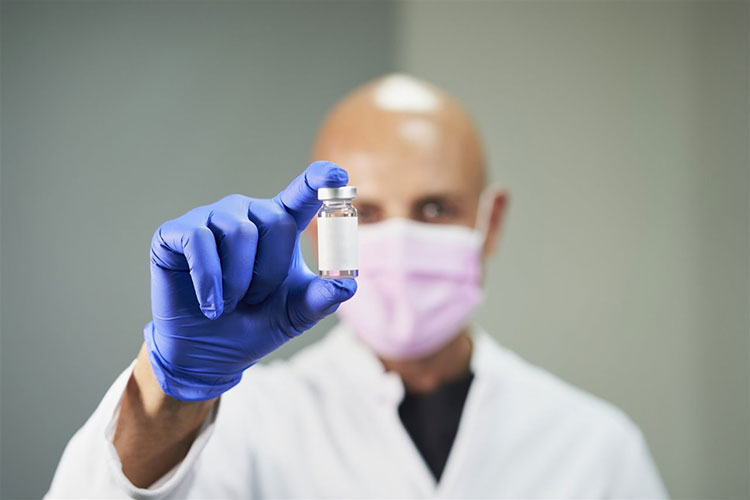
Extravasation Chemotherapy Drugs- Picture Courtesy: National Geography
To define in simple words, these drugs are a type of anti-cancer medicine, especially vesicants that spill out of veins during infusion or injection and go into neighboring tissues and destroy them. Indeed, they’re very potent and effective against tumor cells.
Extravasation chemotherapy drugs fight cancer cells by binding various molecules inside them, like DNA or proteins, thus they stop the cells from multiplying, ultimately killing them. However, they’re also cytotoxic, as when they leak from infused or injected veins, they cause pain, swelling, tissue sores, burns, or even death of tissues. Sometimes, their leakage may result in skin scarring or loss of function in your limbs.
2.Why do you have extravasation chemotherapy drugs in the first place?
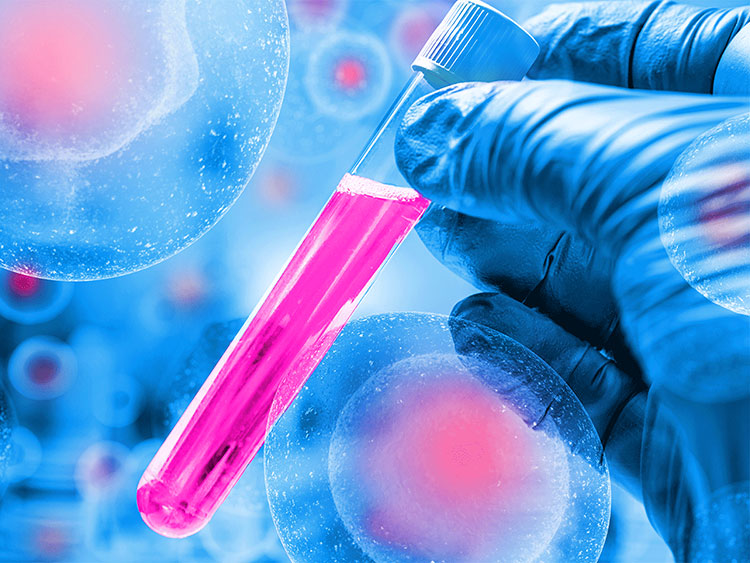
Significance and effectiveness- Picture courtesy: BioWorld
Because sometimes, your cytotoxic drugs are the most effective in destroying the cancerous cells. Extravasation chemotherapy drugs are included in this category of drugs, as when administered correctly in a patient’s vein, they are life-saving. Here are the reasons why these anticancer drugs are still favored despite their risks:
| Long-Standing Clinical Success | Scientists have conducted trials on these drugs in thousands of studies over the past few decades, and they’ve been proven successful in increasing patient life expectancy. Hence, with their predictable efficacy and well-documented results, oncologists all across the globe rely on them to fight cancer. |
| Very Potent Neoplastic Agents | Unquestionably, extravasation chemotherapy drugs are the most potent cancerous drugs to exist till now. They come very handy when oncologists are trying to treat various forms of cancers, such as solid tumors, lymphomas, sarcomas, leukemias, and breast cancer. |
| No Equivalent Substitute | This may come as a surprise to you, but even after decades of research on chemotherapy agents, there still isn’t any equivalent substitute for extravasation chemotherapy drugs in various cancer treatments. So, if you omit or replace them with other anti-cancerous agents, it might compromise the effectiveness and success rate of treatment. |
| Part of Life-Saving Combination Regimes | Because of their high success rate, extravasation chemotherapy drugs are often a vital part of various multi-drug treatment plans, for example, ABVD for Hodgkin lymphoma. Hence, if these drugs are taken out of the regimen, it could weaken the whole treatment outcome. Consequently, there is an increased chance of relapse. |
| Effective Systems to Manage Risks | Many patients worry about the extravasation risk of these drugs. However, today at oncology centers and hospitals, trained staff are present to proficiently handle challenges associated with extravasation chemotherapy drugs, and they take proactive steps, for instance, the use of central lines and infusion pumps to prevent extravasation from happening in the first place. |
3.What are the main extravasation chemotherapy drugs?
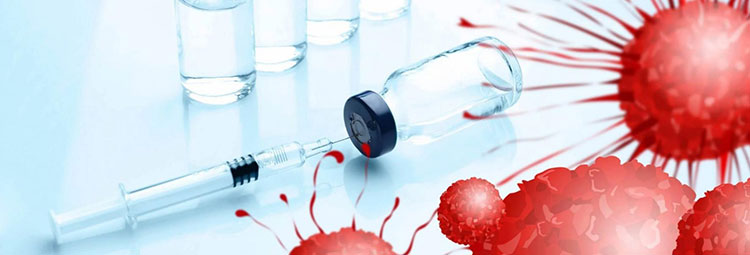
Categories- Picture courtesy: Booking Health
Do you know there are diverse classes of extravasation chemotherapy drugs? Yes, even though you might call them by the name of vesicant but there is a lot more about them that you don’t know. Hence, we’re penning some main classes of extravasation chemotherapy drugs below for your knowledge:
| DNA Binding Agents | Although these extravasation chemotherapy drugs are known for their lethal damage to cancerous cells, they also cause severe damage to normal cells of the body. They bind with the DNA in the cells, resulting in the disruption of the cell cycle. They include anthracyclines (daunorubicin, epirubicin) as well as antitumor antibodies (dactinomycin, mitomycin). |
| Non-DNA-Binding Agents | As the name suggests, they don’t bind with DNA molecules but with other molecules, like proteins. Like most of the chemotherapy agents, they also stop cancer cells from multiplying. Even if they cause major tissue damage if they leak from blood vessels, however, they’re more quickly and effectively removed from tissues. And hence, their tissue injuries are less damaging or persistent than those generated from DNA-binding agents. Usually, vinca alkaloids like vincristine and taxanes (paclitaxel) at higher volumes are included in this category of extravasation chemotherapy drugs. |
| Irritants with Vesicant Ability | Commonly classified as irritants due to their ability to cause pain and inflammation without tissue blistering, however, they may act like a vesicant drug at specific concentrations or circumstances. For example, cisplatin at a higher concentration of 0.5mg/ml behaves like extravasation chemotherapy drugs. |
4.What are the operational steps of developing extravasation chemotherapy drugs?

Operational Steps- Picture courtesy: Globela Pharma Pvt
Have you thought about developing procedures for chemotherapy drugs? Well, you should know that the preparation of these anticancer agents, especially extravasation chemotherapy drugs, is a multi-step operation, where each step is executed after careful planning and with extreme precision. If you’re interested in learning about these manufacturing steps, here is a simplified overview just for you:
| Pre-Formulation and R&D | Before diving straight into preparation, the development activities of extravasation chemotherapy drugs start with pre-formulation research and development. At this stage, you’ve to first choose your desired extravasation chemotherapy drug, then evaluate its cytotoxic potential, and assess its physicochemical characteristics, for example, its solubility, pH, and stability.
Furthermore, you’ve to outline risk degrees for extravasation based on the mechanism of action of the drug. |
| Formulation Development | Secondly, before ordering of drug compound, you should choose appropriate excipients, for example, buffers, stabilizers, and solvents, to improve the safety and potency of the selected drug and to minimize tissue damage in the event of extravasation.
You can consider developing liposomal or nanoparticle vehicles for extravasation chemotherapy drugs to decrease tissue toxicity. Moreover, it is important to select the right type of leak-proof containers that keep drugs stable. |
| Dispensing of Raw Materials | Now that your planning phase is completed, you’ll order your bulk drug substance from a trusted supplier who fulfills every quality audit. Once it is delivered, your next step will be to safely store it in your cold-storage chain till its use. |
| Solution Preparation | When it’s time to make formulation, you’ll retrieve your drug compound from cold storage and thaw it within contained systems, like isolators, to ensure it isn’t exposed to the surrounding atmosphere. After that, you’ll collect your drug compound in larger tanks equipped with stirrers.
Remember to prepare your preparation in the cleanroom. In most of the extravasation chemotherapy drug preparations, you dissolve your active ingredients and excipients in Water for Injection. To stop microbial growth in your formulation and to prevent product oxidation, you can employ nitrogen sparging during manufacturing, as it removes oxygen. |
| Sterile Filtration and Aseptic Transfer | Yes, every piece of packaging, whether vials or closures, is disinfected using autoclaves, sterilization tunnels, or irradiation before product filling. Also, you filter your formulation using ultrafine membrane filters to ensure there isn’t contamination of any kind- biological, physical, or chemical in it.
After filtration, materials (vials, syringes, product solution, and stoppers) are moved to filling rooms using sterile transfer ports or isolators. |
| Aseptic Filling | A core step in the development and manufacturing of extravasation chemotherapy drugs. Simply, you use filling lines to load your formulation in the pre-disinfected containers. Typically, you carry out this stage in the isolators (sealed systems with integrated glove ports to avoid product contact). Or laminar flow hoods, like Class II/III biological safety cabinets. |
| Lyophilization | If your extravasation chemotherapy drugs are unstable in their aqueous phase, you can freeze-dry them to extend their shelf life by converting them into powdered form.
This process is carried out at low temperatures under reduced pressure settings to vaporize frozen water without changing it to liquid first. After lyophilization, the partially sealed containers with rubber stoppers are crimped to secure them. |
| In-Process and Quality Control Testing | At each stage, during the manufacturing of extravasation chemotherapy drugs, manufacturers have to ensure working steps proceed smoothly proceeding onward without any errors. Hence, they’ll carry out pH, osmolality assessment, appearance, and weight check assessment.
Furthermore, once the medication is filled in containers, you conduct a quality control check to verify that these drugs are formulated and packed according to quality control standards. |
| Visual Inspection and Rejection | Before labeling of extravasation chemotherapy drug containers, they’re manually or automatically examined to detect any particulate matter (dust, fibers), fill level variations, container anomalies (scratches, cracks, weak seals), color changes, etc. So, if these containers don’t pass any of the criteria, they are separated from the rest of the batch and moved to the rejection tray. |
| Packaging and Labeling | As extravasation chemotherapy drugs are hazardous, their containers must be labeled appropriately. In this step, you utilize labelers to paste the necessary information and tags on your containers. With integrated printers, you can also incorporate QR codes on packaging for scanning.
To ready product containers for shipment, they’re secured by loading them in sturdy boxes. Mostly, these cartons are made with erecting, folding, and sealing of paperboard sheets. |
5.What machines are present in extravasation chemotherapy drug production?
Having an understanding of various machines found in extravasation chemotherapy drug production is key to making these medications in the right way. Here we’re describing every piece of equipment briefly for your understanding:
| Water Treatment System | To purify your source water, you must have a water treatment plant, like a multi-effect distillator or reverse osmosis system. In this system, water is treated by various steps, such as backwashing, acid cleaning, disinfection, etc. You’ll find that this plant consists of several subunits, for instance, membrane filters, terminal water tanks, and more. | 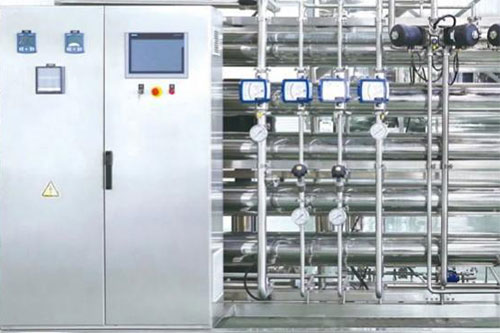
AIPAK Engineering Water Treatment Plant |
| High Shear Mixer | For compounding and mixing purposes, often high shear mixer is often used in extravasation chemotherapy drug manufacturing facilities.
It is a cylindrical, sealed vessel in which dry mixing and wet mixing of active ingredients, solvents, and excipients are performed to create an evenly distributed mixture. |
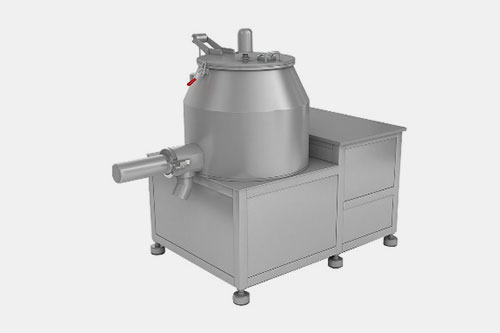
AIPAK High Shear Mixer |
| Vacuum Homogenizing Emulsifier | You can think of this machine as a closed vessel used for mixing your immiscible liquids to form a stable extravasation chemotherapy drug emulsion.
It is the machine that helps you in producing sterile injectable formulation. Mixing is possible in this equipment by high-speed shearing forces that fragment particles to sub-micron size. |
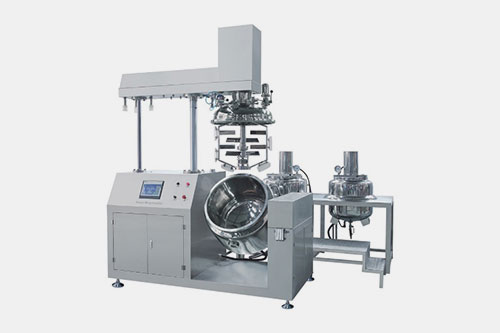
AIPAK Vacuum Homogenizing Emulsifier |
| Sterile Filtration Units | Prior to loading formulation in a container, it is once again passed through various filtration systems, normally, ultrafine membrane filters. These filters use 0.22 µm sterilizing-grade membranes to filter out microbes from drug preparation.
With high pressure, the drug solution goes across the membrane with smaller particles, like a solution passing through them. Larger impurities, bacteria, molds, and others are retained on the membrane. |
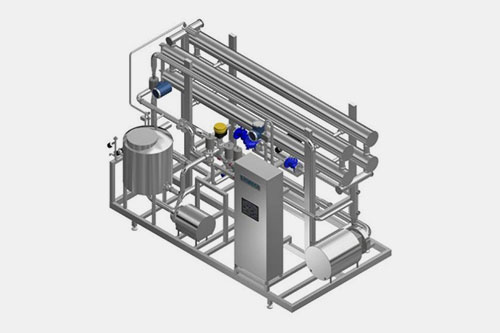
Filtration Systems- Picture Courtesy: Synelco |
| Aseptic Filling Machines | Yes, you can use a variety of machines to fill your containers, for example, a vial filling line, an ampoule filling line, and a prefilled syringe filling line.
Clearly, you’ll spot that these aspectic filling lines are not a single equipment but instead many units are integrated with each other to process and dose vials, ampoules, and prefilled syringes. The units in these filling lines wash, sterilize, fill, and deal containers. |
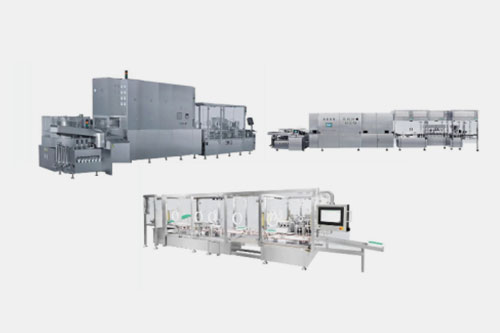
AIPAK Engineering Aspectic Filling Machine |
| Lyophilizer | As you probably know by now, some kinds of extravasation chemotherapy drugs are unstable. Hence, to boost its stability, these medications are freeze-dried in the lyophilizer.
It is a tunnel-like system in which shelves are fitted to place vials. At low temperatures, the product is frozen, and then after applying heat and vacuum, frozen water is converted into gas vapors. In this manner, you obtain a dry and stable powder. |
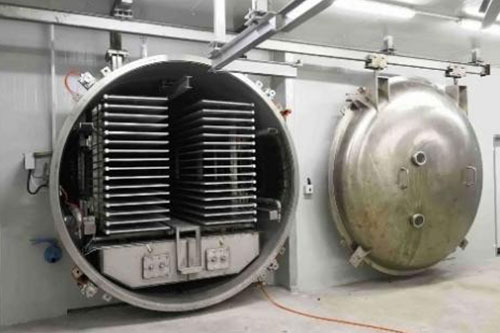
AIPAK Vacuum Lyophilizer |
| Labeling System | Information is vital when it comes to extravasation chemotherapy drug administration. So, brands communicate product facts using various labels.
For this reason, a labeling system is needed in industrial units to apply labels having facts regarding product names, ingredients, dosage, warnings, and storage instructions. |
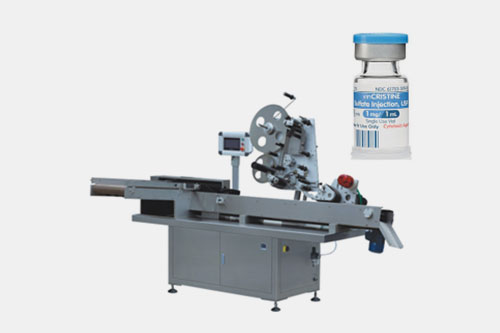
AIPAK Labeling System |
| Cartoning Machine | At the end of extravasation chemotherapy drug manufacturing, you’ve got a cartoning machine.
This is the unit that is responsible for securing the drug containers by loading them in a carton. The product boxing process is automated using it. Its function is to erect, fold, close, or seal boxes. |
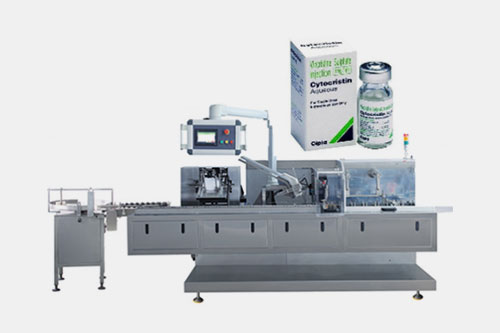
AIPAK Cartoner |
6.Who is most at risk of complications from extravasation chemotherapy drugs?
After reading about hazards associated with extravasation chemotherapy drugs, you are probably wondering who is more likely to face extravasation. Read the section below to get your answer:
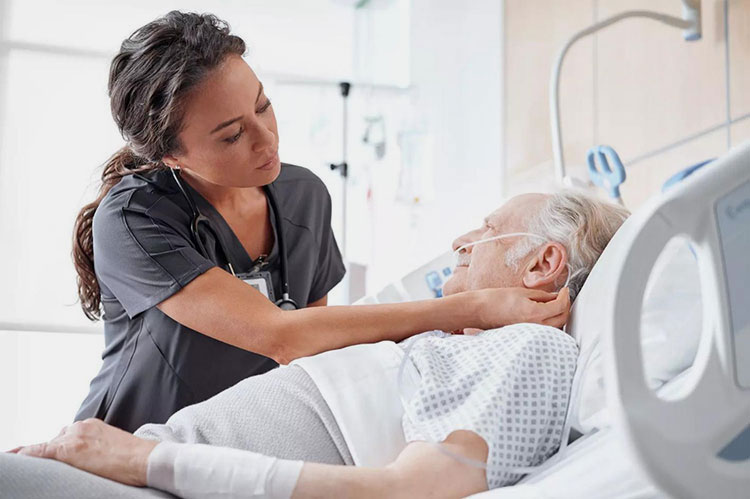
Complications- Picture courtesy: Hillrom
| Patients Having Delicate or Hard-to-Find Veins | Elderly or pediatric patients are usually included in this group. They’ve fragile and weak veins. Moreover, cancer patients are also vulnerable to drug leakage because they’ve numerous IV lines or may’ve poor circulation.
Also, it’s hard to find veins in dehydrated or underweight patients. Undoubtedly, they’ve more chances of vein bursting or drug escape from the veins. |
| Individuals Undergoing Vesicant Therapy | You’re spot on. Individuals receiving an infusion of vesicant drugs have a higher risk of complications, such as blistering, ulcers, pain, numbness, and even tissue death. Examples of vesicant drugs are doxorubicin, paclitaxel, etc. |
| Peripheral Line Infusion | If patients are infused with extravasation chemotherapy drugs in peripheral veins instead of central veins, like in the chest or neck, they may have a higher probability of experiencing extravasation.
Little veins in forearms, wrists, or hands are more prone to drug spilling, vein tearing, or needle misalignment. |
| Longer Infusion Duration | Lastly, longer infusion duration means a longer time in which the drug sits near the vein, in turn leading to more of risk of its escaping. |
7.How do you administer extravasation chemotherapy drugs?
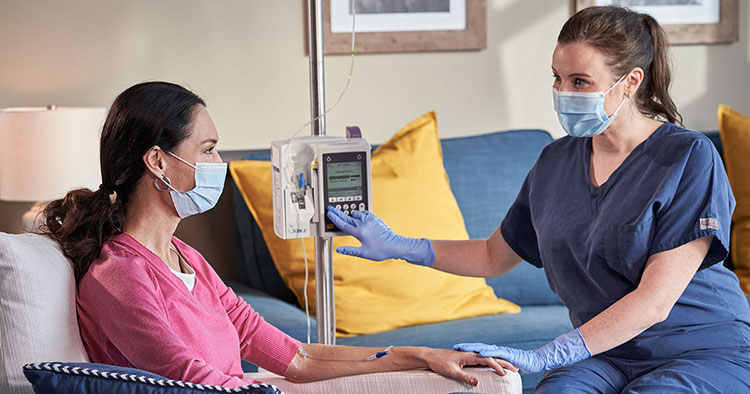
Extravasation Chemotherapy Drugs- Picture Courtesy: Cancercentre
It is quite obvious that the administration of extravasation chemotherapy drugs is considered one of the very high-risk procedures in cancer centers and hospitals. Some of the standard practices of administering extravasation chemotherapy drugs are:
| Peripheral IV Administration | In this method, hospital staff put a small, elastic catheter or cannula into a visible vein present in the hand or forearm of the patient. Extravasation chemotherapy drugs may be injected into this vein using a syringe for a few minutes.
This procedure is called IV push or bolus. However, it is a high-risk method because a large volume of the drug is present in the injection site. In the short peripheral infusion approach, extravasation chemotherapy drugs are first mixed with a lower volume of compatible fluid and are infused for a longer duration of about 15-60 minutes. |
| Central Venous Access Device (CVAD) Administration | Yes, your guess is right. This method uses a catheter inserted into a central vein. Often, CVAD is favored for infusion of extravasation chemotherapy drugs over peripheral administration because this vein has a larger blood flow through which the drug is quickly diluted. Consequently, lowering the extravasation risk.
For CVAD infusion, patients either have a small reservoir surgically placed under the skin in the chest area, with a catheter attached, which goes into the chest vein. Or individuals have a catheter tube inserted in their forearm vein adjacent to their elbows, and this tube is guided into a vein near the heart. |
8.What instant steps should you take if extravasation chemotherapy drugs leak during the infusion?
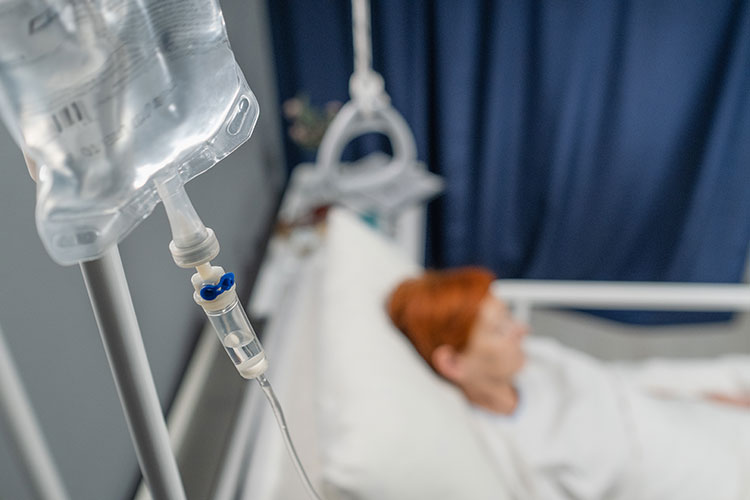
Instant Steps To Stop Leakage- Picture Courtesy: Mangal
Quickly taking action can make a lot of difference between mild and severe tissue damage in case of extravasation. When extravasation chemotherapy drugs leak during infusion, instantly following established protocols can prevent blisters, nerve damage, or even surgery. Here should be your step-by-step plan if you’ve got an extravasation event on your hands:
First and foremost, quickly stop the infusion. Although it is important not to remove the IV cannula or needle yet, simply pause the pump or manually secure the IV line. This allows you to aspirate the drug. Also, you should attempt to extract as much remaining medication as possible through the IV line with the help of a syringe. Keep in mind not to flush the line, as it pushes drugs much deeper into tissues.
After aspirating the drug, quickly give the right antidote to the patient. Apply a cold compress for most of the vesicant drugs for 15-20 minutes, mostly 4 times, for the next 24-48 hours. You have to apply a warm compress if the patient is being infused with vinca alkaloids and oxaliplatin.
9.What antidotes in oncology centers reduce extravasation chemotherapy drugs?

Antidotes- Picture courtesy: National Foundation
There is no need to worry as oncology centers are trained to act fast in case of extravasation chemotherapy drugs by using antidotes. These are the powerful agents that quickly defuse and disperse anticancer drugs before they cause long-term tissue damage. Some of the antidotes present in oncology centers are detailed below:
| Dexrazoxane | Considered as the gold standard in the case of anthracycline (vesicant) chemotherapy drug extravasation. Do you know that it chelates iron, thereby preventing free-radical damage produced by anthracyclines? It is given as IV and its infusion begins in just 6 hours of extravasation. |
| DMSO (Dimethyl sulfoxide) | Anyhow, it is applied topically directly to damaged skin. Regarded as an anti-inflammatory because of its function, which is to neutralize cytotoxins. Moreover, it also acts as a free radical scavenger. |
| Hyaluronidase | As the name suggests, it disintegrates hyaluronic acid in the connective tissues of patients. This assists in drug dispersal and dilution in these tissues.
Unlike dexrazoxane, it is administered as a subcutaneous injection in areas surrounding the damaged tissues. In the case of vincristine, vinblastine, and paclitaxel injuries, you’ll give the hyaluronidase antidote to patients. |
| Sodium Thiosulfate | You can inject this antidote into and around the extravasation region. It chemically reacts with alkyl chemotherapeutic drugs and neutralizes them. |
10.How do extravasation chemotherapy drugs differ from drug infiltration?
People often confuse extravasation chemotherapy drugs with drug infiltration, but they are vastly different from each other. They both involve accidental leakage of drugs, but their effect on adjacent infusion sites is markedly distinct. Let’s discuss some of their fundamental differences:
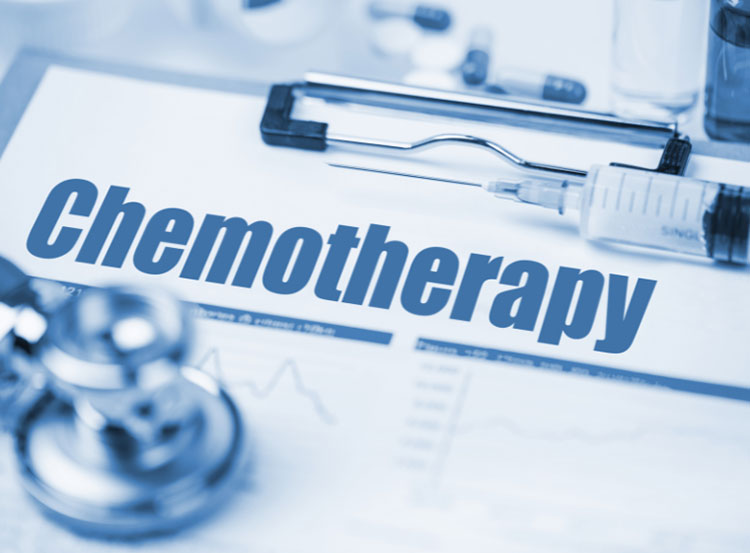
Chemotherapy Drugs Differ From Drug Infiltration- Picture Courtesy: Istanbul Med
| Features | Extravasation | Drug Infiltration |
| Leakage Compounds | In case of extravasation, vesicant chemotherapy drugs leak from the veins. | Infiltration is caused by the spillage of non-vesicant IV fluids, for example, saline, antibiotics, etc. |
| Tissue Damage | Extremely severe, like blistering, skin grafting, or tissue death. | Minor, mild, and easily reversed. |
| Reaction | Harsh burning, high-level pain, and inflammation that is not always instant. | Moderate swelling and little discomfort. |
| Treatment | Emergency procedures, for instance, antidotes, and surgical intervention. | You just need the elevation as well as a cold or warm compress. |
| Long-term Impact | Very high, such as may have tissue loss, infection at the extravasation site, as well as delayed healing. | Low |
11.How long should you monitor the injection site after infusion of extravasation chemotherapy drugs?
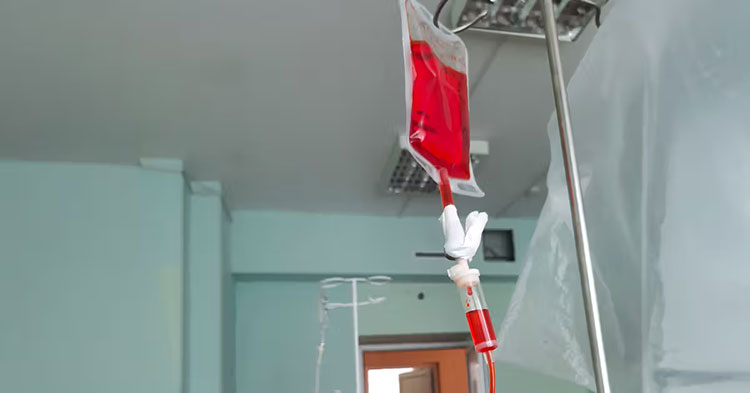
Monitoring of infusion- Picture courtesy: Healthline
It is a common misconception that monitoring the infection site after infusing extravasation chemotherapy drugs is an immediate process and doesn’t need long-term assessment. However, the reality is that there is no fixed duration, as it may involve immediate assessment or long-term follow-up. For your learning, here is the breakdown of how long you should monitor the injection site:
| Immediate Phase
|
It is a very important phase, as the majority of extravasation events occur during the first hours of infusion. Hence, you must observe the site more frequently, for example, every 15-30 minutes for the first few hours.
Once the initial hours are passed, examine the infusion area every 4-6 hours for the first 24-72 hours. |
| Subacute Phase
|
In this phase, patients and their caregivers are instructed to check the infusion area daily at home for the first week to one month. They’re instructed to look for extravasation symptoms and seek emergency care. |
| Long-Term Monitoring Phase | Yes, it is true that some extravasation injuries, especially those involving DNA-binding chemotherapy medications, occur long after infusion. So, patients can have delayed reactions, as tissue damage is not evident until days, weeks, or even months of infusion.
That’s why patients are advised to remain vigilant after infusion and immediately report to their doctors if they experience worsening symptoms. |
Conclusion
By now, you’ve probably realized the fact that extravasation chemotherapy drugs aren’t your ordinary medications. Because of even one mistake during their manufacturing, packaging, or administration, patients, healthcare staff, or manufacturing workers may experience blistering or tissue scarring. Here is the good news: you can easily counteract extravasation by using the right manufacturing equipment, smart packaging, and training response team. Still, got more queries about these meds? We, AIPAK ENGINEERING, are here to support you by helping you understand the complexities of extravasation chemotherapy drugs or in choosing the right equipment, cleanrooms, and packaging solutions for minimizing extravasation events.
Don't forget to share this post!
CONTACT US
Tell us your raw material and project budget to get quotations within 24 hours.
WhatsApp Us: +86 181 7101 8586
 Tell us your material or budget, we'll reply you ASAP within 24 hours
Tell us your material or budget, we'll reply you ASAP within 24 hours

